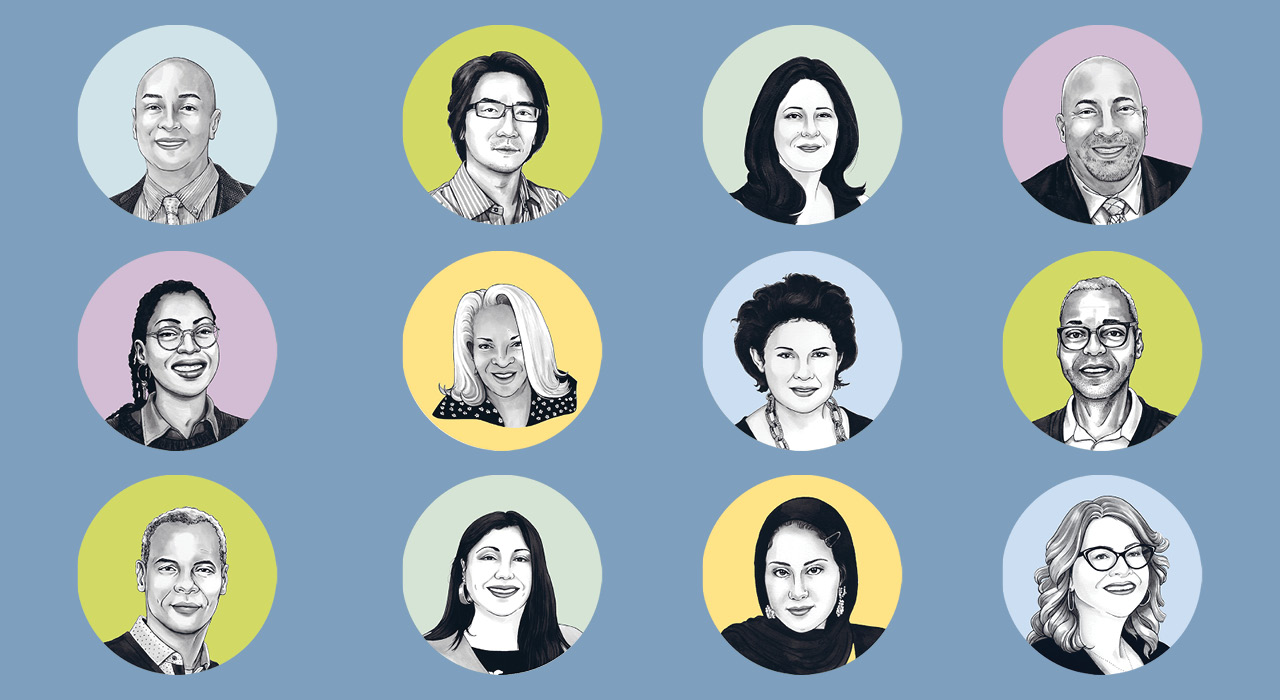

Faculty, staff, and students across the college discuss their vision for an inclusive FIT—and how we can get there
Illustrations by Lily Qian, adjunct instructor
Our community is engaging in necessary conversations—and actions—to ensure FIT’s leadership in the fight for social justice and equity for people of color. Hue asked 12 faculty members, students, and administrators about what we are doing—and should do—to address these urgent issues on campus and beyond.
Most agreed that FIT needs to recruit more students and faculty of color, infuse the curriculum and approach to teaching with diverse perspectives, provide resources to support BIPOC students, and help make the creative industries welcoming to all. They see the new Social Justice Center at FIT (SJC) as an important development toward true diversity, equity, and inclusion (DEI).
Vernon Goodman-Keating, assistant director of Admissions and Strategic Recruitment, said, “As a person of color who has battled many of the issues that the SJC is looking to remedy throughout my career, I am proud to be a part of an institution that has made this call to action a reality.”
He believes the establishment of the SJC helps FIT stand out from other institutions and recruit BIPOC students, since it shows that the college is committed to their success.
Here are brief excerpts from these conversations.

Ron Milon, PhD
Chief Diversity Officer
Across the board, higher education is struggling with diversity in their faculty makeup and student enrollment. We’re not the only school dealing with this. But the solutions most institutions come up with are Band-Aids. We have to be proactive, not reactive. For example, we don’t say we’re hiring; we’re recruiting. How can we make job descriptions more inclusive? Where can we put job postings so that diverse candidates are more likely to see them? If you continue to cast the fishing net the same way, you’re going to get the same fish.
When art and design students apply, you look at their portfolio. What about the possible superstars who didn’t have the help they needed on theirs? We are thinking about ways to go into high schools to work with students, to get them ready for FIT.
After the events of 2020, we asked ourselves how we could build a more inclusive culture within FIT. One thing we did was transform the President’s Diversity Council, which had served in an advisory role, just organizing programming and distributing grants. A lot of areas of the college were not represented in the Diversity Council: In order for DEI to be in our DNA, everyone has to take part. We created a Diversity Collective of 15 units that represent every academic and administrative area of the college. Each unit has two chairs who work on initiatives like curriculum changes, hiring practices, programming, and policies. We talk about things like student pronouns and resources for faculty to create an inclusive learning environment. With this collective, we’re constantly putting our feet to the fire to get things done.
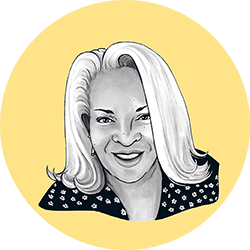
Shawn Grain Carter, MA ’09
Associate Professor, Fashion Business Management
In my 21 years of being here, the new African American and Africana Studies minor is the greatest thing I could have contributed to this college. I’ve thought this curriculum was necessary for years. When I did my master’s, I was told you can’t do your thesis on Black designers because there are not enough of them. Evidently, nobody thought Black people have contributed to this industry. That’s when it crystallized for me. But we never had enough courses to make a minor—a lot of them were electives that ran once and you never saw again.
In the spring of 2020, the students spoke up. They wanted more faculty of color. They wanted more courses about our contributions to the industry. I proposed the minor, and Yasemin Jones in Academic Affairs helped to fast-track it.
In my classes I teach the story of Elizabeth Keckley, a former slave who designed Mrs. Lincoln’s dresses. We have never taught that at FIT. Ann Lowe designed Jackie Kennedy’s wedding dress. She was not just a seamstress: She was designing; she had her own business; she was an entrepreneur. Patrick Kelly was the first American designer to be admitted to the Chambre Syndicale du Prêt-à-Porter, which governs the French ready-to-wear industry. He happened to be a Black man from Mississippi.
Students need to know the contributions of Black people, not just in design but also fabric construction, business, modeling, and brand development. Most people don’t realize that Michael Kors got his start in department stores because of a Black buyer named June Horne at Saks Fifth Avenue. A Black buyer at Bloomingdale’s named Nan Puryear is the one who made Calvin Klein underwear a best seller.
Students also learn about Black artists and writers in the Harlem Renaissance—Langston Hughes and his influence on hip-hop. And jazz, the original art form we’ve donated to the rest of the world.

Elena Romero
Assistant Professor, Advertising and Marketing Communications
With the Social Justice Center, FIT’s task is twofold—looking outward to take a lead in the conversation with the industry, and looking inward. Can we do a better job here in terms of being student-centered? It’s a big challenge, with no one-size-fits-all solution. My students did a class project about FIT’s cafeteria, and they discovered the food didn’t address the vast food needs; there aren’t enough gluten-free, vegan, halal, or kosher options. The best way to be sure we’re on target with students is to ask them what they need. What will make them feel comfortable at the college? Empowered? We should reexamine the FIT curriculum across all departments. Are we telling that broader narrative? When we teach about fashion designers, are they mostly white, thin, and cisgendered? It matters. When you teach journalism like I do, are you thinking of news in a patriarchal way? You need to get out of your comfort zone as a journalist if you want to report a story accurately. To reach certain communities, for example, you might need to work with a translator. With diversity, equity, and inclusion, at the core we’re saying we show empathy and love. That’s not about hugging the students—it’s about finding out who they are. We’re already doing some of this work, but we can do it better, and be intentional.
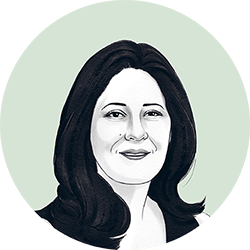
Tanya Melendez-Escalante, MA ’04
Senior Curator of Education and Public Programs, The Museum at FIT
We need to create a respectful community for everyone. Respect and disrespect replicate, and disrespect replicates faster. We focus on teaching and learning, but we forget about people who aren’t in a classroom environment. We need to make sure everyone at FIT, including staff members, public safety officers, and maintenance staff, are treated equitably. If they’re not, what do our first-generation college students, whose parents might be blue-collar workers, think about that? We’re all part of one community. When a security guard gets berated in the museum because they ask a visitor to take off their backpack, that’s a member of our team who is suffering. In general, the museum field has a long way to go in terms of diversity. I’ve been at MFIT for 13 years, and the inclusiveness conversations started a long time ago. The museum made an investment in mannequins with different shades. It was complicated and expensive: Could we retrofit what we already had? What garments go with which mannequins? But there was a strong institutional commitment to doing things differently. For the speaker series I curate, Fashion Culture, I write DEI reports. I love reports! The series needs to include a multitude of approaches to fashion—culture, business, and identity. I don’t want to only feed people one point of view; that’s boring, and it’s important that we include many perspectives.
“Respect and disrespect replicate, and disrespect replicates faster.”
— Tanya Melendez-Escalante
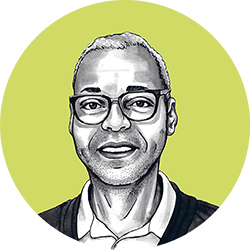
Mark-Evan Blackman ’84
Assistant Professor, Fashion Design–Menswear
We have a moral obligation to our students. If they’re talented and unique, they should be in the game. Many years ago, when I first took over as chair of Menswear, I could not place a single student at a certain internationally known fashion house, even though I had so many polished kids. Finally, the firm took one, and then the door was open. Today, if we pulled all the Menswear grads out of that company, it would collapse. Preparing students for the realities of the industry—it’s not just a Black issue, and it’s not a one-time conversation. There are hundreds of learning opportunities for students, teachable moments every day. If I ever used the wrong fork, I want someone to correct me, and do it gently. In my class, every teachable moment is honored. I say hi to all my students, and I know them all by name and I respect them. I’ve noticed many faculty don’t do that. If the faculty want to effect positive change, we have to model the behavior and show empathy for our students.
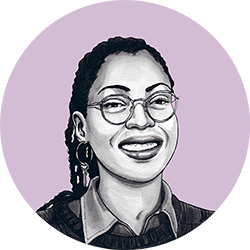
Lonnie Brown
Advertising and Marketing Communications ’23
Equity and justice at FIT means giving students of color platforms to voice the changes they want to see and bring their experiences to light. The biggest challenge is that when students of color feel they need to speak out, often it’s because the cup is overflowing and we can’t take it anymore. When we do get those opportunities, there’s a passion behind it that I feel is seen as anger. Providing people of color who can talk to us, give counsel, and move our complaints and demands upward would be amazing. And the Social Justice Center is a good start.
There are also a bunch of clubs at FIT centered around people of color, like the Black Student Union, the Asian Student Network, and Spotlight, a collective that aims to highlight BIPOC and LGBTQ+ students. I’m the creative director of Spotlight, and I feel like it’s my child. I’m focusing on providing a link between first-years, older students, and alumni. There’s a mentorship program in the works to give people a more solid idea of where their majors and careers could lead.

Amy Lemmon, PhD
Professor and Chair, English and Communication Studies
Recently I found a syllabus left on the photocopier in my office, and the faculty member had included a diversity statement that said: “You are welcome in this class.” That’s the bottom line, right?
The poetry world and the publishing world have already had a reckoning with diversity and inclusion. Writers of color, women and LGBTQIA+ writers, disabled writers are finally being foregrounded in the current literary climate. This makes it easier for me to provide different perspectives; I can point students to the work of diverse writers, and bring them to campus as guest speakers.
I have brought speakers such as Claudia Rankine, Ocean Vuong, and Jericho Brown to FIT. It’s important for students to see that we’re connecting them with significant creators in the culture. And they need to be encouraged to bring their personal lives, their culture, their identity, their family, their interests into what they’re writing.
My department co-sponsored a faculty workshop by Felicia Rose Chavez, author of Anti-Racist Writing Workshop, which offered strategies to give writers of color a voice. She gave examples from her own experience in graduate school of feeling like her work was ignored because she was writing from her working-class Chicana identity. In the traditional workshop model, everyone critiques the work while the writer stays silent; the work is supposed to speak for itself. In Chavez’s model, students provide the context for their work as they share, and they have more fruitful interactions. It’s about listening to the students and giving them a space to articulate where they’re coming from.

C.J. Yeh
Professor, Advertising and Digital Design
As an Asian immigrant, the biggest DEI issue for me is stereotyping. People expect you to be quiet and obedient; sometimes they’re surprised that I speak up. When I started teaching, Asian students told me it meant a lot to them to see me being successful—it gave them hope and confidence. I was happy about that, but also sad because their experience had told them an Asian wasn’t supposed to be there.
Students need to see people of different races and cultural backgrounds in positions of authority. True equity will be when there’s no surprise at that. Still, I believe FIT is doing better than other schools where I’ve taught. I see people who are comfortable being themselves, expressing themselves.
Professor Christie Shin and I created a Design for Social Impact certificate program. We tell students, “Use your creative superpower to change lives in some way.” Experts come and talk about how to create a more inclusive environment. My father has Alzheimer’s and it’s heartbreaking when patients can’t recognize family members, so there were tears in my eyes when a student created an app that uses vibration to connect Alzheimer’s patients to their caregivers. The program’s last lesson is to stop thinking, What should I do? Just do it. Even a small thing can make a difference—removing the label from a garment, using environmentally friendly ink, making sure there are captions in your app. Big things are made of small parts.
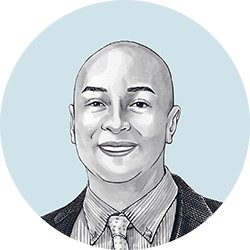
Vernon Goodman-Keating
Associate Professor and Assistant Director of Admissions and Strategic Recruitment
One of our biggest challenges is to reach different communities of BIPOC students. Some forgo college because of costs, and don’t understand that FIT is publicly funded. They need to know they can afford a top-tier education. Over the last 10 years, we have made huge improvements to our enrollment strategy, but there are limits to how many meaningful interactions we can have with prospective students. More resources would help us widen the search. BIPOC students also need to be able to talk to current students to distinguish what’s true from what they see on social media about FIT.
To feel welcome and secure on campus, students of color need to be introduced as early as possible to the structures that ensure diversity at FIT, including the Office of Diversity, Equity, and Inclusion and the Title IX office. Admissions has begun doing that in our Open House and Admitted Students Day programs.
In the admission process we encounter so many students who hope to find their tribe here. When they do, different parts of their identity are awakened and affirmed in ways that may not have been possible in their previous environment. It is a beautiful thing to take part in, and one of my favorite parts of doing this type of work. I would love a campus resource that allows faculty, staff, and students to explore how we can best support each other through these discoveries.
Diversity is not just about BIPOC students. For instance, we’re collaborating with Media Services to make it possible for hearing-impaired applicants to fully participate in virtual information sessions. True equity means also serving students who don’t always bubble up to the surface of DEI conversations.
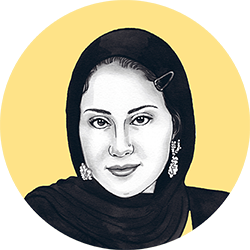
Namra Khan
Fashion Business Management ’22
I’m a Pakistani Muslim woman, a first-generation American, so my interest in diversity came naturally—but I never saw myself working in DEI until I explored the topic of sustainability.
Everything changed when I watched The True Cost, a documentary about fast fashion’s impact on the environment and people. I listened to women of color beg the Western fashion industry to change, and I made it my mission to fight the industry’s exploitation of BIPOC—this is where sustainability and diversity intertwine. I founded a Clinton Global Initiative University project called Waste X Change, a platform that works to uplift sustainability in the fashion industry. We focus on everything from environmental racism to transparency.
I’m a diversity, equity, and inclusion intern at Prada. I get to shape instrumental partnerships, engagement strategies, and workplace culture to create an industry where people of all backgrounds have the opportunity to share their talent. It’s been an amazing experience, and they really value my perspective.
Not only is championing DEI the right thing to do, but it just makes good business sense in terms of employee retention, brand value, and profitability. Finally, the industry is waking up. Leaders are saying that if you aren’t advocating for diversity, you’re not innovative. That’s been giving me hope.
“Leaders are saying that if you aren’t advocating for diversity, you’re not innovative.”
— Namra Khan
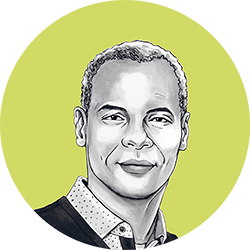
Eric K. Daniels
Professor, Interior Design
True equity and inclusion at FIT would mean everyone is valued for what they bring to the table—their story. Not just students, but faculty too. I’m an architect. I went to Pratt in 1980. One reason I got in was a lawsuit: For the first time, the architecture school accepted 12 African American students; they only had one or two before then. Though FIT has a mandate as a state school, the Interior Design Department remains homogeneous, maybe only three Black and Latinx students in 20. Exposure to the design field has to start in elementary school; by high school, everyone’s made up their mind. Throughout the country, art programs are nonexistent in grade schools, especially in urban and rural areas. I have given presentations that introduce urban junior high school students to architecture and interior design. At FIT, I’m always trying to get my students to be socially responsible, and engage local communities in the design processes that affect their environments. I teach a service learning studio course, where they design spaces such as a drama room, science room, library, or outdoor garden for K through 6th graders, with a real client—New York City public schools.
The Social Justice Center is such a great mountain of an idea, and although I love scholarships, it really comes down to policy. I have a student who has 10 siblings, and she’s responsible for three of them. For true equity, you need to address childcare, homecare, affordable housing, food insecurity, and access to education. The SJC needs someone who can think like an architect—holistically.
“True equity and inclusion at FIT would mean everyone is valued for what they bring to the table—their story.”
— Eric K. Daniels
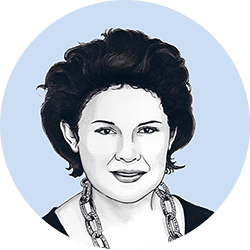
Brooke Carlson, ScD
Interim Dean, School of Graduate Studies; Associate Professor, Cosmetics and Fragrance Marketing and Management
I believe in allyship. That means the “in group” needs to emphasize social justice, inclusion, and human rights, and purposefully advance underserved or marginalized groups. That works to our mutual benefit. How can you serve the national and global consumer if your organization doesn’t mirror those populations?
We need to provide formalized mentorship for students with alumni in the industry. And organizations need to actively recruit for internships and entry-level positions, and then have a plan to ensure that these diverse individuals can succeed and integrate into the organizations. Our industries have to be more representative in all types of positions, at every level up to the top. That means corporate culture needs to change and be open to new voices and new ways of thinking.
We must educate underserved young people about the varied career paths offered in the creative and business industries. There are so many layers to the industries that serve fashion brands—supply chain and operations, sales, advertising, strategic marketing, social media. Students also need to know our programs go beyond the “F” in FIT.
Our biggest challenge is the magnitude of the need for social justice, and that’s why the Social Justice Center is so important. These efforts must be sustained and embedded in everything we do.
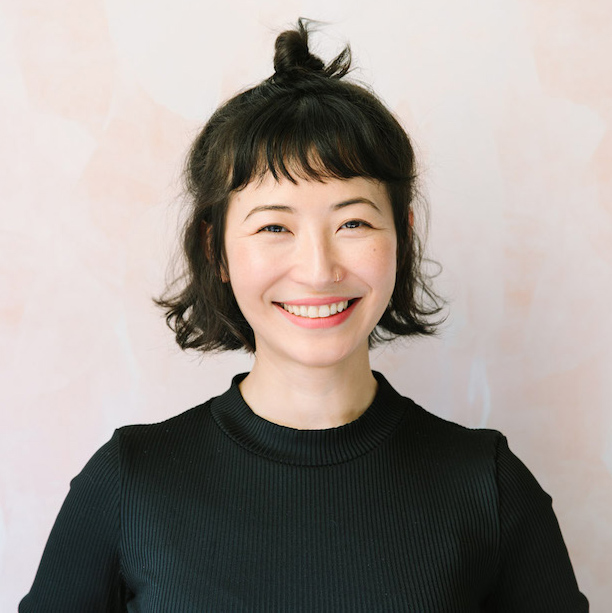
Lily Qian is a New York City–based illustrator, designer, and educator with a passion for both traditional analog and digital techniques.
She takes inspiration from experimenting, exploring accidents that occur when mixing different materials and textured backgrounds. Clients include Apple, Teen Vogue, Christian Dior Couture, Louis Vuitton, and Tiffany & Co. She teaches Illustration at FIT.